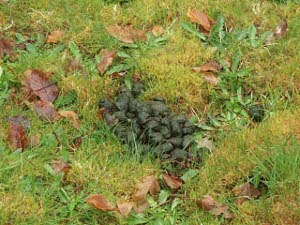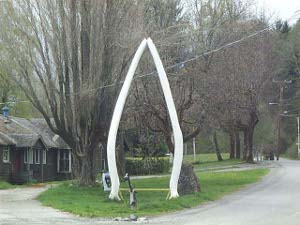 Deer bounding
map, saying they aren't printing any more. So we offer it to the first reader who requests it; it shows the North Island from the lumberman's perspective.
Deer bounding
map, saying they aren't printing any more. So we offer it to the first reader who requests it; it shows the North Island from the lumberman's perspective.
Our ferry to Prince Rupert didn't leave till late afternoon, giving us time to wash the truck, count three more eagles and one osprey, and take a trip deep into logging country. The Port Hardy tourist office gave us a logging company  Deer bounding
map, saying they aren't printing any more. So we offer it to the first reader who requests it; it shows the North Island from the lumberman's perspective.
Deer bounding
map, saying they aren't printing any more. So we offer it to the first reader who requests it; it shows the North Island from the lumberman's perspective.
In this area the logging cycle is about 70 years. The companies claim this produces the greatest average annual yield, but it may be just what the government allows. There are signs telling when each section was planted, thinned, fertilized, harvested -- which in turn indicate the lumber companies are paying a lot of attention to public relations, perhaps in fear of the Green Party. The companies also establish campgrounds and boat launching ramps for public use. The land itself belongs to the sovereign and is leased to the loggers.
The logging roads, like those in the forests of Maine and eastern Canada, are private, with the public allowed to use them at their own risk. We've never encountered a logging truck in a tight situation -- perhaps because we haven't ventured on the roads that climb up the hillsides! Also, there's no lumbering on the weekends, like today.
After about an hour's drive, passing a fair number of pickups, and getting well splattered with mud, we saw an adult black bear in the wood. He / she stopped to look at our truck. We drove slowly ahead, then the bear turned  Rainforest
and quickly disappeared into the woods, before we could snap a picture.
Rainforest
and quickly disappeared into the woods, before we could snap a picture.
The further away we were from Port Hardy, the worse the road got. Still, it was always drivable. We went through Holberg, a most unremarkable logging town, and continued west towards Cape Scott. Our destination was Ronning's Gardens.
The tourist literature told us that Bernt Ronning, a Norwegian immigrant, established his homestead (in the middle of nowhere) in 1910. The rest of the original settlers eventually left, but Ronning remained till the 1960s, trapping and fishing, sometimes working as camp cook for the loggers. He always welcomed hikers; his house had a room for dancing with a pump organ. Whenever he had a bit of extra money, he would send away for seeds, and eventually developed a garden with trees and plants from faraway places. Two monkey puzzle trees have produced viable seeds - a rare occurrence in North America. New owners are trying to keep the gardens going.
Just before the entrance to the garden we spotted a doe and fawn in the  Mossy trees
road. Mom disappeared almost at once, but the fawn trotted down the road just ahead of the car. Trot trot trot and then a curious, funny stiff-legged bounce: trot trot trot bounce bounce bounce bounce trot trot trot, the fawn led us down the road right to Ronnings Garden parking area, then took the turnoff to the old cemetery and stared at us as we got out of the car, and finally disappeared.
Mossy trees
road. Mom disappeared almost at once, but the fawn trotted down the road just ahead of the car. Trot trot trot and then a curious, funny stiff-legged bounce: trot trot trot bounce bounce bounce bounce trot trot trot, the fawn led us down the road right to Ronnings Garden parking area, then took the turnoff to the old cemetery and stared at us as we got out of the car, and finally disappeared.
The parking area was a wide patch of grass and gravel big enough for two cars; we hadn't seen another human since we left Holberg, and we were two hours from Port Hardy. Really out in the wilderness. And there were bears. The little sign on the road said Ronnings Garden 1/2 mile Please Walk. We had benefited from the pamphlets obtained at the Port Hardy Visitors Centre so we talked loudly and sang just to let the bears know we were coming.
The rain forest surrounding us was as dense and lovely as anything we've yet seen. Except for the temperature, we might have been in the Amazon. Moss grew luxuriantly on everything, giant ferns covered the ground, little daylight penetrated the canopy, trees which fell uncounted numbers of years before lay  Possibly bear droppings?
rotting, covered with undergrowth. But the little road was open -- two black stone gravel tracks with yellow green grass between -- and we walked back into the forest. It was quite improbable to imagine there was a garden ahead. We were sure there were bears, and we wouldn't have been too surprised to see giant anacondas dangling from the limbs of trees!
Possibly bear droppings?
rotting, covered with undergrowth. But the little road was open -- two black stone gravel tracks with yellow green grass between -- and we walked back into the forest. It was quite improbable to imagine there was a garden ahead. We were sure there were bears, and we wouldn't have been too surprised to see giant anacondas dangling from the limbs of trees!
Anyhow, at the top of the rise was a nice sign, along with a guest book and a place for donations. We walked through parts of the garden, and admired the monkey puzzle tree. It was raining steadily and the grass was ankle high, so we didn't stay long. Besides, we came upon a large pile of animal droppings and imagined it might just be from a bear. Is there an outdoorsperson among our readership who can identify the stuff in this picture? The whole pile was about a foot in diameter, and three or four inches high.
So we walked back to the truck, down the long road through the beautiful rainforest, singing and talking loudly, jingling keys. The truck was still there, there were no more deer, so we got in and began to retrace our route to Port Hardy.
We saw another bear on the way back. Or possibly the same one -- they all look alike. Again he or she was off the road before we could get the camera in position.
 Shoe Tree
Shoe Tree
Just before turning back to the highway we spotted a major local landmark: the shoe tree, established in 1989 by a trio of Port Hardy women, just for fun. Footwear of all description has been nailed to a giant cedar snag (dead tree.) About ten years ago, driving through northern France, we saw another shoe tree, with shoes placed like Christmas decorations, hanging from the ends of the limbs. A different effect.
Back in town we washed the truck again and had lunch. With several more hours to spend, we drove first to Port Alice and then to Coal Harbour. Port Alice is a pretty lakeside town with well-kept houses. It's situated on Neroutsos Inlet, about 50 km sailing to the Pacific. This is another of those deep fjords that penetrate the west coast of Vancouver Island.
Coal Harbour was once a whaling town. In front of the municipal building is a twenty foot jawbone of a blue whale, along with a blue painted harpoon gun,  Jawbone of a whale
symbols of past glory. The tourist literature also mentioned a huge open pit copper mine that went far below sea level, but ceased operation in 1996. We got directions and drove to the location, but the gate was locked and no one was present on a Saturday. The pit was one mile by three-quarters of a mile.
Jawbone of a whale
symbols of past glory. The tourist literature also mentioned a huge open pit copper mine that went far below sea level, but ceased operation in 1996. We got directions and drove to the location, but the gate was locked and no one was present on a Saturday. The pit was one mile by three-quarters of a mile.
We've seen a good bit of Vancouver Island. It runs from highly civilized at Victoria, the provincial capital and a major tourist destination, through the prosperous small cities around Nanaimo, to relatively untamed and unpopulated wilderness in the north. The entire island is a tree farm, but lumbering employs fewer people each year as more labor-saving equipment is developed. Fishing is in decline, and there are likely to be continued hard feelings between fishermen, as some can claim First Nations descent and thereby be entitled to take more fish "for the elders." Tourism -- especially ecotourism -- is growing, and the year-round temperate climate makes British Columbia an attractive retirement venue for Canadians from the cold interior.